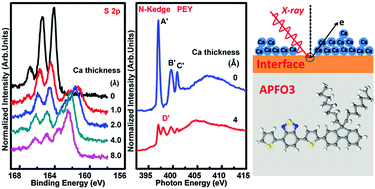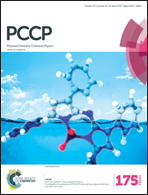Interface properties between a low band gap conjugated polymer and a calcium metal electrode
Abstract
Interfaces between metal electrodes and π-conjugated polymers play an important role in the organic optoelectronic devices. In this paper, the molecular orientation of the pristine poly[(9,9-dioctylfluorenyl-2,7-diyl)-alt-5,5-(4′,7′-di-2-thienyl-2′,1′,3′-benzothiadiazole)] (APFO3) films, chemical reactions and the electronic structure during the interface formation of Ca/APFO3 have been investigated in detail using synchrotron radiation photoemission spectroscopy (SRPES), X-ray photoemission spectroscopy (XPS) and near-edge X-ray absorption fine structure (NEXAFS) spectroscopy. It is shown that the APFO3 film has a high degree of orientational ordering with its aromatic ring tilted at an angle of 43° from the substrate, and the 9,9-dioctyl fluorene unit (F8) is almost in the same plane as the benzothiazole unit (BT). Upon vapor-deposition of Ca onto APFO3 at room temperature, Ca dopes electrons into APFO3 and induces the downward band bending of APFO3. Moreover, Ca can diffuse into the APFO3 subsurface and react with N, S and C atoms of APFO3. Finally, the barrier of electron injection at the Ca/APFO3 interface is derived by the energy level alignment diagram. These results enable us to gain comprehensive insights into APFO3 and will facilitate the reasonable design of high performance devices based on APFO3.



 Please wait while we load your content...
Please wait while we load your content...